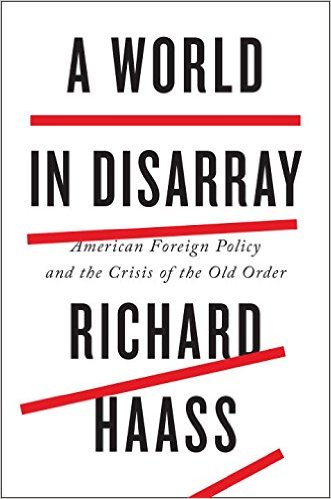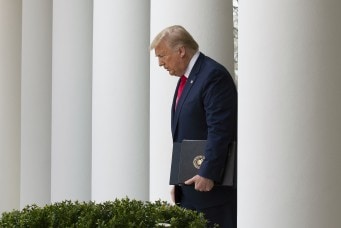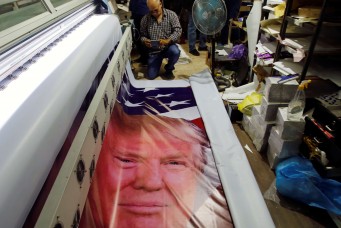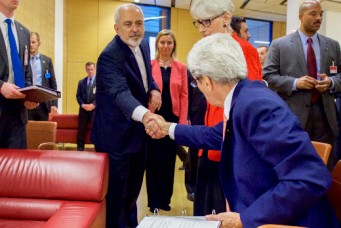Crisis of Confidence
Does the world matter to Americans?
A World in Disarray: American Foreign Policy and the Crisis of the Old Order. By Richard N. Haass. Penguin Press, New York, 2017. 352 pp.
Whatever the lasting institutional impact of the Trump revolution, it has surely thrown the Washington foreign policy establishment into a state of panic. Many of the mostly apolitical professionals at the State Department, the Pentagon, and other national security agencies are experiencing dread, both at the content of the Trump administration’s early policy decisions and at the processes by which they were promulgated. Particularly turbulent has been the White House’s relationship with the intelligence community, as details of Trump associates’ curious relationships with Moscow seep into the front pages of the New York Times and Washington Post.
With the bureaucracy girding for massive budget cuts, even Republicans on Capitol Hill are wary—wary of Trump’s unpredictability and unpopularity, of his ambivalence for conservative orthodoxy, of the power of a weaponized tweet. The rest of the foreign policy establishment—including journalists, business interests, and foreign diplomats—have been struggling to navigate unfamiliar and treacherous waters.
Amid this uncertainty comes Richard N. Haass’s new book, A World in Disarray: American Foreign Policy and the Crisis of the Old Order, on the fraying global system and America’s role in it. The book begins—like Henry Kissinger’s 2014 World Order—with an outline of the evolution of international order from the Congress of Vienna, which concluded the Napoleonic Wars, through to the twentieth century’s Cold War and its aftermath. Haass brims with ideas throughout, so much so perhaps that he lacks Kissinger’s patience in developing this historical analysis into a framework for better understanding today’s turbulence.
Haass, a former U.S. government official and diplomat who has been president of the Council on Foreign Relations (CFR) since 2003, provides an expert tour d’horizon of the many pressing geopolitical and geo-economic challenges facing the United States in the Trump era. A reader is sometimes challenged to keep up as Haass reviews in less than twenty pages the breakups in Czechoslovakia and Yugoslavia in the 1980s and American military operations in Iraq, Somalia, and Haiti in the 1990s to the U.S. invasions of Afghanistan and Iraq in the 2000s. He offers valuable insights, such as an analysis of why the Asia-Pacific region has been more stable in recent decades than the Middle East. (Three reasons: the Asian countries’ prioritization of economic development; their more developed national identities; and American support for Japan, South Korea, and other Pacific partners.)
With profound technological and economic transformations feeding a global wave of populist discontent, it was inevitable that the new American president taking office in 2017 would face daunting questions about America’s place in the world. Haass clearly intended A World in Disarray be to a guide to the incoming administration, and the book contains prescriptions on reconstructing the world order.
Central to Haass’s argument is the notion of “sovereign obligation,” described as “the need to develop and gain support for a definition of legitimacy that embraces not just the rights but also the obligations of sovereign states vis-à-vis other governments and countries.” This approach, outlined in broad strokes, is a global order based on interdependency, in which the United States plays a unique role, and faces unique responsibilities. Given the dollar’s role as de facto global reserve currency, Haass argues that Washington has a responsibility to consult with others in fiscal or monetary policy deliberations.
What is fascinating—and, to many foreign policy hands, troubling—is how the Trump administration is so starkly at odds with the framework within which Haass and the foreign policy establishment have long operated. “From this day forward, a new vision will govern our land,” Trump declared at his inauguration. “From this moment on, it’s going to be America first. Every decision on trade, on taxes, on immigration, on foreign affairs, will be made to benefit American workers and American families.” Among Trump’s initial decisions in the Oval Office was to withdraw the United States from the Trans-Pacific Partnership, an ambitious multilateral Asian trade agreement and a signature Barack Obama administration foreign policy initiative, for which Haass makes an impassioned plea.
The Trump administration promises not a tactical recalibration, but a wholesale change of course. The disarray it has caused in Washington and foreign capitals is not at all what Haass has in mind, yet it is precisely what many Trump supporters voted for. Indeed, one of the most remarkable incongruities of the complex socioeconomic and technological transformations in recent decades is that they are empowering politically the very elements who feel most threatened by them economically. Haass, as the head of a nonpartisan foreign policy think tank headquartered on New York’s Upper East Side, personifies the Eastern elite Trump voters revolted against.
Candidate Trump openly cultivated the political support of the previously fringe conspiratorial right as part of his core political base. Infowars, the website run by media provocateur Alex Jones, carries frequent denunciations of Haass’s organization’s covert corporatist agenda to assert control over the United States and the world. (Full disclosure: The reviewer is himself a member of CFR, though his role in this global conspiracy is negligible.) Shortly after his November election victory, Trump appeared on the radio program of Jones—who claims September 11 was an inside job and that NASA faked the moon landing—and praised Jones’s “amazing” reputation.
In the decades following the end of World War II, and after the collapse of the Soviet Union in particular, U.S. diplomatic and political supremacy was taken for granted in Washington. American foreign policy practitioners, Democrats and Republicans alike, could generally imagine global challenges as existing “out there,” at least partially insulated from the messy vagaries of domestic politics. For a time, at least in the 1990s, it seemed there was no foreign policy challenge too big or too small for the United States to take on.
How times have changed. Although many Trump supporters voted to seal themselves off from the world outside, the 2016 U.S. presidential election is stark evidence of just how narrow the distance between America and the world has become. Many of the problems “out there”—institutional stresses, political upheaval, power redistribution, extreme polarization—are not really so different from the problems “in here.” Meanwhile, the traditional tools of statecraft—military force, diplomacy, economic and humanitarian assistance—are losing their efficacy, particularly in the Middle East. While these deep structural changes date to the end of the Cold War in the early 1990s, when the United States was at the apogee of its military and political power, the Trump administration has embraced them. Thus, what White House strategist Steve Bannon calls the “deconstruction of the administrative state” manifests itself in a budget proposal that would slash 28 percent of the joint budget for the State Department and the Agency for International Development and which could significantly reduce America’s diplomatic footprint and its capacity to respond to complex global crises.
Haass seeks to make the case that “the world matters to Americans.” That is certainly true, but he exerts little effort to explain how the myriad geopolitical challenges described in A World in Disarray affect the lives of Americans outside the Washington bubble, tens of millions of whom rallied instead around Trump’s message of economic nationalism. The rise of Trumpism did not occur in a vacuum, but in the context of an increasingly polarized political culture, in which large majorities of Americans distrust Congress, the media, and even the new president himself. Indeed, the book outlining a compelling program to address the corrosive impact of this domestic crisis of confidence—and in so doing to rejuvenate America’s atrophying foreign policy capacity—has yet to be written.
Perry Cammack is a fellow in the Middle East Program at the Carnegie Endowment for International Peace and a lecturer at the Elliott School of International Affairs at George Washington University. He served on the policy planning staff in the office of U.S. Secretary of State John Kerry from 2013 to 2015 and as a senior profes- sional staff member for Senator Kerry on the U.S. Senate Committee on Foreign Relations from 2009 to 2012. On Twitter: @perrycammack.





